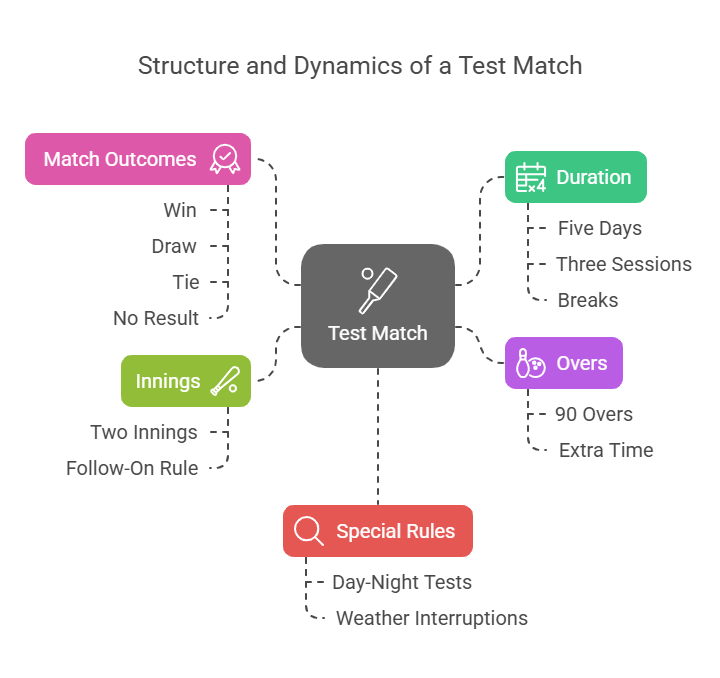How Long Is a Test Cricket Match? Duration, Days & Details

Want to know how long is a Test cricket match really?
Grab your chai, cause we’re about to discuss this 5 day long joyous match. Test cricket is the OG of the game. Slow, strategic and full of action play. Let’s talk about why it is a long match and why fans still love it.
How Long is a Test Match in Cricket?
A Test match in cricket is the longest format of the sport, traditionally played over a period of five days, with each day up to 90 overs. Let’s break it down in full detail:
Standard Duration: Five Days
A typical Test match is five consecutive days, from morning to evening.
- Each day has three sessions: morning, afternoon and evening.
- Two breaks in between: lunch (40 minutes) and tea (20 minutes).
Play starts around 10:00 AM to 11:00 AM local time, depending on the venue and country.
Overs Per Day
90 overs are scheduled to be bowled each day. If overs are not completed due to slow over-rates or minor interruptions, extra time (usually up to 30 minutes) may be added to complete.
In some cases, bad light or rain may prevent full match, this will reduce the number of overs.
Innings Format
Each team gets two innings (a chance to bat twice).
The match can end in:
- A win (when one team outscores),
- A draw (if time runs out before a result),
- A tie (extremely rare, both teams score exactly the same in both innings) or
- No result (if weather washes out most of the game).
Follow On Rule
If Team A leads Team B by 200+ runs after the first innings (in a 5-day Test), they may use the follow-on rule, Team B will bat again immediately. This can affect the overall match flow and influence how long each innings takes.
Match Can End Early
Though for five days, a Test can end in 2, 3 or 4 days if one team dominates. Some famous matches have ended in just 2 days, especially on bowler-friendly pitches.
Rest Days (Historical Note)
In older times, Test matches used to have a rest day (often on a Sunday), making it a 6-day match with 5 days of play. This practice has been discontinued in modern cricket.
Day-Night Test Matches
Introduced in recent years, Day-Night Tests are played with a pink ball under lights. They still last up to five days but begin later in the afternoon and go into the evening. Slightly different conditions affect the match due to dew and artificial lights.
Weather Interruptions
Rain, bad light or unsafe ground conditions can interrupt. Lost time can be made up by extending time on days (starting earlier or ending later). Entire matches may declare draws due to persistent weather disruptions, even with only a few overs bowled.
Test Match Timings by Country (Approximate Start Times)
| Country | Typical Start Time |
| England | 11:00 AM local |
| India | 9:30 AM local |
| Australia | 10:30 AM local |
| South Africa | 10:00 AM local |
| West Indies | 10:00 AM local |
| Pakistan | 10:00 AM local |
| Sri Lanka | 10:00 AM local |
Special Cases: Timeless Tests
In the early 1900s, there were “timeless Tests”, which had no fixed duration. The most famous timeless Test in 1939 (South Africa vs. England) lasted 10 days but was abandoned because England had to catch their ship home.
Cricket Match Formats
Cricket is played in three main international formats, each with proper rules, duration and styles of the match:

1. Test Matches
- The longest format, played over five days.
- Each team has two innings.
- No limit on the number of overs.
- Considered the purest and most traditional form of cricket.
2. One Day Internationals (ODIs)
- Each team plays 50 overs.
- Matches last around 7-8 hours, usually played in one day.
3. Twenty20 Internationals (T20Is)
- Each team plays 20 overs.
- Matches last 3-4 hours.
- The shortest format.
Test Status
Test status is granted by the International Cricket Council (ICC) to the highest level of cricket-playing nations. Only teams with Test status can play official Test matches. As of now, 12 nations have Test status, like Bangladesh, India, Australia, England, South Africa and others.
Test status is a symbol of a nation’s maturity and competitiveness in cricket.
Statistics
Cricket is a statistically rich sport. Key statistics like:
Batting Stats: Runs scored, batting average, strike rate, centuries and fifties.
Bowling Stats: Wickets taken, bowling average, economy rate, five-wicket hauls.
Fielding Stats: Catches, stumpings and run-outs.
Playing Time
Test Matches
Played over five days, with around 90 overs per day. Includes lunch and tea breaks. Matches can last 30-35 hours in total.
ODIs
One-day matches, typically 50 overs per side. About 7 hours including a mid-innings break.
T20s
Quick format lasting 3-4 hours. 20 overs per team, with short innings breaks. Time in cricket also includes interruptions due to weather, light conditions and injuries, impact match duration.
Clothing and Equipment
Clothing
- Test Matches: Players wear traditional white kits.
- ODIs & T20s: Players wear colored kits, often customized by team sponsors and events.
- Special gear like caps or helmets, may have country-specific logos or colors.
Equipment
Bat: Made of willow, weighs around 1.2-1.4 kg.
Ball
- Red (for Tests),
- White (for ODIs and T20s),
- Pink (for Day-Night Tests).
Protective Gear: Helmet, pads, gloves, thigh guards, chest guards, abdomen guard (box).
Shoes: Spiked for grip on grass pitches.
Wicket Keeping gear: Gloves, pads and inner gloves.
Duration of Different Formats
Cricket is a sport with 3 major formats. Explaining below,

Test Match Duration
- Standard Length: Up to 5 days.
- Sessions per Day: 3 sessions (morning, afternoon, evening).
- Overs per Day: Around 90 overs scheduled daily.
- Breaks: 40-minute lunch and 20-minute tea break.
- Total Play Time: Approximately 6-7 hours per day, totaling 30-35 hours over 5 days.
- Early Finishes: Matches can end in 2-4 days if one team dominates.
- Draws: Common if neither side can force a result within the 5-day limit.
- Day-Night Tests: Played under lights with a pink ball, but still follow the 5-day structure.
One Day International (ODI) Duration
- Standard Length: Completed in one day.
- Overs per Team: 50 overs per side.
- Innings Break: A 30-45 minute break between innings.
- Total Play Time: Around 7-8 hours including breaks.
- Match Timing: Usually starts in the morning or early afternoon and ends by evening.
- Rain Interruptions: Can lead to reduced overs using the Duckworth-Lewis-Stern (DLS) method.
Twenty20 Match Duration
- Standard Length: Approximately 3-4 hours.
- Overs per Team: 20 overs per side.
- Innings Break: 10-20 minutes between innings.
- Total Play Time: 90 minutes per innings.
- Match Timing: Often played in the evening or night.
Quick Comparison Table
| Format | Overs per Side | Total Duration | Style |
| Test | Unlimited | Up to 5 days | Strategic & traditional |
| ODI | 50 | 7-8 hours | Balanced & competitive |
| T20 | 20 | 3-4 hours | Fast-paced & thrilling |
FAQs
Where Was The First Test Match Played?
The first-ever Test match was played at the Melbourne Cricket Ground (MCG) in Melbourne, Australia, from March 15 to March 19, 1877. It was a match between Australia and England, this is the beginning of Test cricket as an official format. Australia won the historic match by 45 runs and Charles Bannerman became the first Test centurion, scoring 165.
What Was The Longest Test Match In History?
The longest Test match in history was the “Timeless Test” played between South Africa and England in Durban from March 3 to March 14, 1939. It lasted 10 days.
What Was The Shortest Test Match In History?
The shortest completed Test match in terms of actual playing time was the Australia vs. South Africa match at Melbourne in February 1932. It lasted just 656 balls (or 109.2 overs) and was completed within two days. Australia won by an innings and 72 runs.
